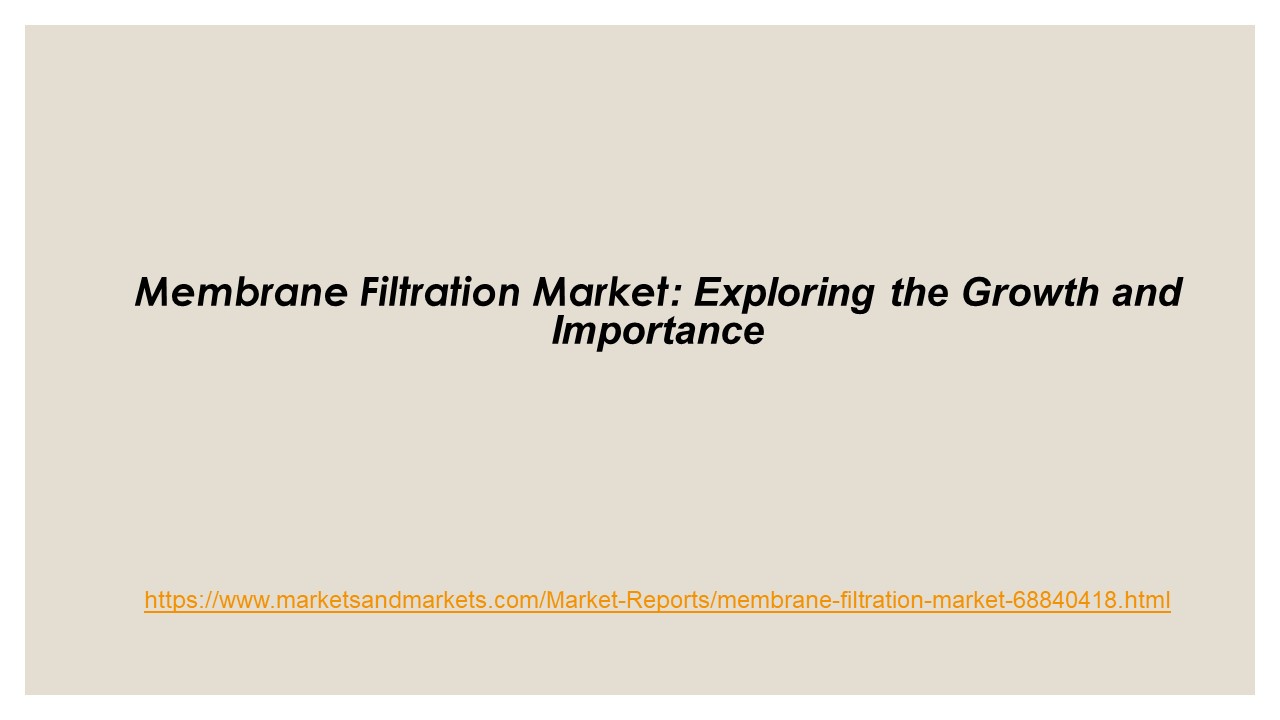New Revenue Sources in Membrane Filtration Market - PowerPoint PPT Presentation
Title:
New Revenue Sources in Membrane Filtration Market
Description:
The membrane filtration market is estimated to be valued at USD 7.0 billion in 2023 and is projected to reach USD 9.9 billion by 2028, at a CAGR of 7.2% from 2023 to 2028. – PowerPoint PPT presentation
Number of Views:1
Title: New Revenue Sources in Membrane Filtration Market
1
- Membrane Filtration Market Exploring the Growth
and Importance - https//www.marketsandmarkets.com/Market-Reports/m
embrane-filtration-market-68840418.html
2
- What is Membrane Filtration Market?
- Membrane filtration is a technology used for
separating particles and solutes from liquids or
gases using a semi-permeable membrane. This
process is widely applied in various industries
for purposes such as water purification,
wastewater treatment, pharmaceutical
manufacturing, food and beverage processing, and
biotechnology. - Which segment by type accounted for the largest
membrane filtration market share? - The reverse osmosis segment dominated the market
for membrane filtration market and was valued at
USD 2.65 billion in 2022. The quality of water
used in food and beverage production can have a
significant impact on the taste and flavor of the
final products. RO-treated water is known for its
neutral taste and lack of unwanted odors or
flavors, making it ideal for preserving the
natural taste of ingredients and beverages. This
drives the demand for reverse osmosis in the
membrane filtration market. - Which are the key players in the market?
- Alfa Laval (Sweden), GEA Group Aktiengesellschaft
(Germany), DuPont (US), Pall Corporation (US), 3M
(US) and TORAY INDUSTRIES, INC.(Japan) are among
the key players in the global membrane filtration
market. To increase their company's revenues and
market shares, companies are focusing on
launching new services, developing partnerships,
and expanding their laboratory facilities. The
key strategies used by companies in the food
pathogen testing market include geographical
expansion to tap the potential of emerging
economies, strategic acquisitions to gain a
foothold over the extensive supply chain, and new
service launches because of extensive research
and development (RD) initiatives.
3
- Market Drivers Rising demand for premium
products - The demand for membrane filtration technologies
in food beverage applications has grown
significantly in recent years, owing to its major
function of removing harmful microorganisms.
Currently, food beverage manufacturers are
increasingly adopting proactive food safety
technologies due to the continuous rise in the
demand for high-quality, safe, and value-added
food products across the world. Membrane
technologies are widely used in the food industry
because they combine the functions of separation,
concentration, purification, and refining as well
as the characteristics of high efficiency, energy
savings, and environmental protection. Dairy
products, soy products, fruit and vegetable
juices, the brewing and sugar industries,
purification and concentration of enzyme
preparations, the concentration of egg whites,
and the separation and concentration of food
additives such as natural colors and spices are
only a few of the major applications. - The membrane filtering industry is seeing
tremendous growth, notably in the dairy, food and
beverage, and wine and beer industries. This
increased interest can be due to a variety of
things. Membrane filtration is increasingly being
used in the dairy industry to improve the quality
and shelf life of dairy products such as milk,
cheese, and yogurt while also removing
contaminants and germs. Similarly, in the food
and beverage industry, membrane filtration is
critical for maintaining the freshness and flavor
of items such as juices, sauces, and soups by
separating solids and pollutants. The membrane
filtration market is estimated to be valued at
USD 7.0 billion in 2023 and is projected to reach
USD 9.9 billion by 2028, at a CAGR of 7.2 from
2023 to 2028.
4
- Key factors contributing to the growth of the
membrane filtration market include - Water and Wastewater Treatment The increasing
demand for clean water and the need for effective
wastewater treatment have driven the adoption of
membrane filtration technologies, especially in
municipal and industrial applications. - Biopharmaceutical Industry The biopharmaceutical
industry relies on membrane filtration for
processes such as protein purification,
concentration, and sterile filtration,
contributing to the growth of the market. - Food and Beverage Industry Membrane filtration
is used for the clarification, concentration, and
fractionation of various food and beverage
products, promoting its use in the industry. - Medical and Healthcare Applications Membrane
filtration is utilized in medical applications
such as blood plasma separation, pharmaceutical
manufacturing, and medical device production. - Technological Advancements Ongoing research and
development activities in membrane technology
have led to the development of advanced membranes
with improved efficiency, selectivity, and
durability, further boosting market growth. - Environmental Regulations Stringent
environmental regulations related to water
quality and emissions have driven the adoption of
membrane filtration systems in industries to meet
compliance standards
5
The Asia Pacific market is projected to dominate
the food pathogen testing market.
- Japan is one of the largest markets for food
pathogen testing in the Asia-Pacific region. It
is also estimated to be a matured market with a
steady growth rate however, concerns for food
safety are still importance to the country owing
to which the enforcement of stringent food
sanitation laws has become mandatory. The
Japanese scrutiny system has revealed food
poisoning through pathogens to be the largest
outbreak across Japan. E. coli was the major
pathogen that caused severe foodborne diseases in
Japan. - In Australia, food pathogen testing has gained a
significant level of importance owing to frequent
increases in the number of foodborne disease
outbreaks, increasingly stringent regulations on
food safety, a growing level of trade between
Australia and other countries, and a sustained
number of food recalls, among other reasons. The
implementation of a food safety system has
reduced the incidences of foodborne diseases in
Australia. The development in technologies and
the increasing number of regulatory norms have
fuelled the growth of this market. The Australian
food industry is using strict quality control
standards and verifies. - To know about the assumptions considered for the
study, Download PDF Brochure https//www.marketsa
ndmarkets.com/pdfdownloadNew.asp?id68840418

